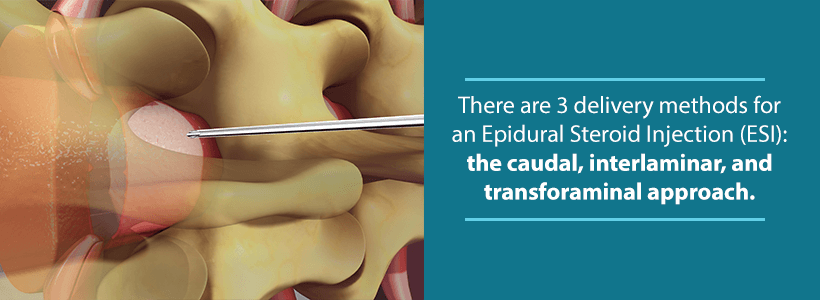If you’re dealing with frequent back or neck pain, your posture might be playing a bigger role than you think. Whether you're sitting at a desk all day or scrolling on your phone for hours,…
An Epidural Steroid Injection (ESI) is commonly used to treat inflammation in the lower back, as well as any related neck and leg pain. In these conditions, spinal nerves become inflamed as the passages where these nerves travel down the spine begin to narrow. (ESIs) can resolve that pain. In addition, your doctor can also use (ESIs) to diagnose which nerves in the spine are causing problems.
Normally, your doctor will inject (ESIs) into the lower back in sets of 2 or 3. This helps to reduce pain, as well as strengthen the lower back. It is important to note that (ESIs) are meant to manage lower back pain, not cure it. With that said, a patient’s mobility will improve and their back will heal quicker because of the decrease in pain. The injections only take less than a minute to administer. And, the performing physician will often follow up an (ESI) with an immediate examination.
How are Epidural Steroid Injections (ESIs) Performed?
Your physician can deliver the steroid into the epidural space through three methods: the caudal, interlaminar, and transforaminal approaches. The common trend between these methods involves placing a needle through the use of fluoroscopic guidance. Before you receive the injection, a nurse or doctor will thoroughly clean the treatment area. Contrast dyes are used to ensure that the steroid travels to the correct area. In many cases, your doctor will use a local anesthetic along with the steroid to make the process less painful for the patient.
The interlaminar approach involves placing the needle into the back of the epidural space, which allows your doctor to deliver the steroid over a wider area. The caudal method is not too different, injecting the needle in a small bony opening just above the tailbone. This allows your doctor to place the needle into the bottom of the epidural space. Using these methods, the steroid will spread over multiple spinal segments which allows for the medication to reach both sides of the spinal canal. With transforaminal (ESIs), or nerve blocks, the needle is placed beside the nerve as it leaves the spine. After which, medication is placed into the nerve sleeve, which then travels up into the epidural space from the side. Using this method, a concentrated dose of the steroid can seep into the affected area.
These (ESIs) can be performed on an outpatient basis, allowing the patient to return to their previous activities the following day. Patients can request mild sedation for the procedure, but most just stick with local anesthesia.
What To Expect
(ESIs) normally begin working within 1-3 days following treatment. However, in rare cases, it may take up to 7 days for you to feel pain relief. Most patients tolerate the injection very well and experience only mild side effects, which resolve within a few days. Diabetics and those with allergies to contrast dyes should discuss these conditions with their doctor before receiving an (ESI).
(ESIs) have been performed for many years and are considered a safe and effective treatment for neck, back, leg, and arm pain. Serious complications are rare and minimized through the use of x-ray guidance. Overall, most patients tolerate (ESIs) very well.
Injections can provide patients with improvement in both pain and function for several months or longer. If the patient notices significant relief, then your physician can repeat these injections without risk to maintain these improvements. (ESIs) are commonly used with other treatments, such as medications and physical therapy, in order to maximize their effects.
Am I A Candidate For An (ESI)?
Patients with low back, neck, arm, or leg pain may benefit from an (ESI). Most commonly, orthopedists use this treatment to address the following conditions:
- Herniated Disc: Irritation, pain, and swelling caused by the gel-like material within spinal discs squeezing out and coming in contact with spinal nerves.
- Sciatica: Pain in the sciatic nerve that travels from the buttocks and down to the legs. Compression of the 1st sacral nerve and the 5th lumbar nerve often leads to this condition.
- Degenerative Disc Disease: Breakdown/aging of vertebrae caused by collapsing disc spaces, annular tears, and bone spur growth.
- Spinal Stenosis: Back and leg pain caused by the narrowing of the spinal canal as well as the nerve root canal.
- Spondylolisthesis: Caused by vertebral fractures/weaknesses that lead to the vertebrae slipping forward and compressing nerve roots
(ESIs) are particularly helpful in treating painful inflammatory conditions. Doctors also use (ESIs) for diagnostic purposes, such as determining whether surgery could help the pain associated with a herniated disc.
In addition to people with diabetes and pregnant women, these injections should not be performed on patients who have bleeding problems or an infection.
What Happens After Treatment?
Patients will be able to walk around directly after receiving an (ESI). Usually, doctors will observe the patient for a short time before allowing them to leave the center. Rarely, temporary numbness or weakness can occur in the legs. So, your physician will advise that you bring someone along who can take you home afterward.
You should be able to resume full activity the next day. However, you may notice some soreness around the treated area, but you can easily treat this by using ice and OTC medicines such as Tylenol. Your doctor will recommend that you keep track of your pain levels as the numbing medicine wears off and the (ESI) takes effect.
Patients may want to schedule a follow-up visit with their doctor to address any and all concerns.
Are you considering an (ESI) for your treatment? If so, contact our board-certified spine and orthopedic experts at OLSS. Our practice has clinics in Florida, New Jersey, and New York, as well as a team of award-winning experts whom you can trust.




